|

by Martha Rosenberg
May 9, 2012
from
HuffingtonPost Website
|
Martha Rosenberg
frequently writes about the impact of the
pharmaceutical, food and gun industries on public
health. Her work has appeared in the Boston Globe, San
Francisco Chronicle, Chicago Tribune and other outlets. |
Big Agriculture's Big Secrets:
9 Things You Need to Know About the Food
You Eat
Food scandals are so costly to Big Food that it has repeatedly
tried to kill the messenger rather than
clean up its act.
Thanks to factory farming's massive economies of scale, a lot of
food today is disgusting or cruel or disgusting and cruel.
Just when people stopped talking about
cantaloupes with deadly
listeria, "pink slime" hit the
news. And just when people stopped talking about pink slime, ground
beef treated with ammonia to kill germs, mad cow hit the news.
Does anyone even remember the arsenic in
the fruit juice?
Food scandals are so costly to Big Food, it has repeatedly tried to
kill the messenger rather than clean up its act. In the 1990s it
pushed through "food disparagement" laws under which Oprah Winfrey
herself was sued by cattlemen in 1997 (Winfrey said she would never
eat a hamburger again upon learning that cows were being fed to
cows).
Winfrey was acquitted and cow
cannibalism was made illegal but the US still lost $3 billion in
beef exports when a first mad cow was discovered in 2003. April's
new mad cow will not help foreign trade.
Last year, Big Food introduced Animal Facility Interference laws in
several states which make it a crime to,
"produce, distribute or possess
photos and video taken without permission at an agricultural
facility."
The bills also criminalize lying on an
application to work at an agriculture facility "with an intent to
commit an act not authorized by the Owner" - in an effort to stop
the flow of grisly undercover videos.
The first facility interference offense
would be an aggravated misdemeanor but subsequent offenses could be
felonies.
Of course, the Ag-Gag bills, as they were quickly dubbed, are
anti-free-speech and would chill both whistle-blowers and news media
(who couldn't legally even receive non-approved farm images). The
bills were scarified by CNN, the New York Times, Time magazine and
First Amendment and food safety activists and, luckily, were
defeated in 2011. But they are creeping back.
Many farmers and agricultural professionals are miffed that the days
of "it's-none-of-your-business" farming are over.
Once upon a time, consumers cared only
about the price and wholesomeness of food and didn't worry about -
or videotape - its origins and "disassembly." Now consumers
increasingly want to know how an animal lived, died, and even what
it ate in between.
Some of the newly engaged consumers are
motivated by health, wanting to avoid hormones in milk, antibiotics
in beef, arsenic in chicken, and who knows what in seafood. But many
are also motivated by humane concerns.
Here are some shocking facts that Big Food would like to mute with
Ag-Gag and food defamation laws:
-
rBGH in Milk - We're Drinking
What?
Recombinant bovine growth
hormone (rBGH), injected into dairy cows to increase milk
production, was created by crossing cow DNA and E. coli
bacteria. Yes, that
E. coli.
From the start, farmers and
veterinarians worried about the udder infections it causes,
the resulting need for more antibiotic usage and more.
"I surely wouldn't want to
eat from the hypodermic pockmarked section of the cow,"
said one farming critic as early as 1994.
Banned in many countries and
unlabeled here, rBGH-produced milk also contains pus and a
protein associated with increased prostate and breast cancer
risk called IGF-1.
Still, Eli Lilly, who bought
rBGH in 2008 from Monsanto insists, it,
"safely increases
productivity of dairy cows" and helps "family farm
owners."
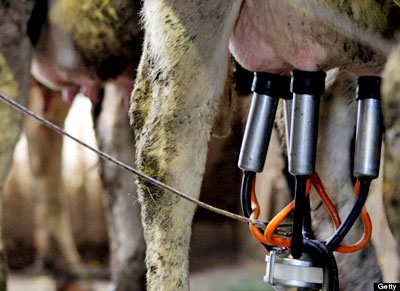
-
Eggs With a Side of Salmonella
Two years ago, a
salmonella outbreak caused the recall of half a billion eggs
and 1,600 illnesses.
Thanks to factory farming, with
thousands of hens stacked over their own manure, egg
operations are festooned with germs. In fact, the government
found both Tyson Foods and a hatchery injecting eggs of
future laying hens preventively with antibiotics to avert
infections. Yum.
Austin "Jack"
DeCoster, to whose
farms the salmonella was linked, had a 30-year history of
health and safety violations. In fact, when authorities
raided his Turner, Maine operation in 2009, charging him
with animal cruelty, four officers required treatment for
ammonia-burned lungs just from entering his barns.
Yet DeCoster received no
penalties for the salmonella outbreak and enjoyed a gracious
retirement.
-
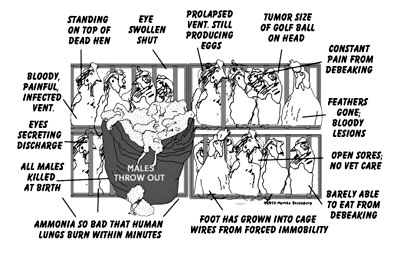
-
The Drug Store in Your Meat
You may not have heard of
Fort Dodge, Elanco, or Intervet, animal divisions
of Big Pharma, but you may well be "taking" their drugs.
Government safety inspectors
miss residues of penicillin and other antibiotics, parasite
and anti-inflammatory drugs and heavy metals in beef, says a
2010 Office of Inspector General report, allowing
contaminated beef into food supply.
For other toxins like dioxin,
lindane and fire retardants, inspectors do not even have
"established action levels" to test for. Four plants, with
an astounding 211 drug residue violations, were given a pass
says the OIG report.
Worse, unlike germs like
salmonella or E. coli, drug and metal residues aren't
neutralized by cooking and can even turn into more dangerous
compounds when heated.
-
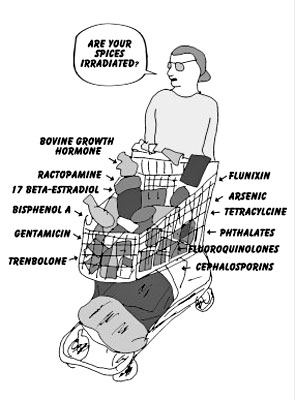
-
"Free Antibiotics" in Food and
Water
One of the late Sen. Ted
Kennedy's last legislative fights was about the overuse of
livestock antibiotics.
"It seems scarcely
believable that these precious medications could be fed
by the ton to chickens and pigs," he wrote in the
Preservation of Antibiotics for Medical Treatment Act.
Over 70 percent of antibiotics
go to livestock, not to people, says the bill and 48 percent
of national streams are tainted with antibiotics.
Other reports say that almost
half of Midwest hog farms harbor the antibiotic resistant
germ, MRSA, and 64 percent of workers carry it. Are people
who don't eat meat or drink tap water safe? Guess again.
Crops themselves can harbor
antibiotics, say food researcher, siphoning them right up
from the soil.
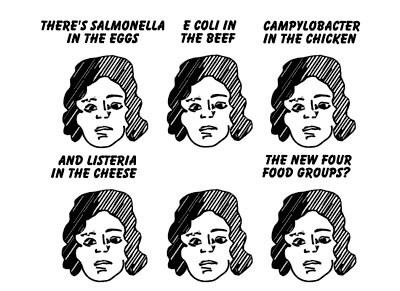
-
Meat Inspection by the "Have a
Cup of Coffee and Pray" Method
Once upon a time, federal
meat inspectors visually examined carcasses for
wholesomeness.
But under the Hazard Analysis
and Critical Control Points (HACCP), implemented in 2000,
inspectors now simply ratify that companies are following
their own self-created systems - as in "Trust us." Soon
after HACCP, 80 percent of inspectors surveyed said that
HACCP limited their ability to enforce the law and the
public's right to know about food safety.
Almost 20 percent said they'd
been told to not document violations. And 62 percent of
inspectors said they allowed contamination like feces,
vomit, and metal shards in food on a daily or weekly basis
since HACCP.
No wonder HACCP has been been
dubbed "Have a Cup of Coffee and Pray."

-
A Delicacy from Hell
Foie gras is a "delicacy"
that requires the indelicate force-feeding of geese and
ducks to bloat their livers.
Video shows birds with bloody
throats, barely able to walk and struggling to breathe. Yet
Big Food, restaurateurs and even the American Veterinary
Medical Association defend the gratuitous cruelty lest veal
crates and other extreme "production agriculture" be
questioned next.
Foie gras is banned in Europe
and other countries but a 2007 foie gras ban in Chicago drew
ridicule from the Chicago Tribune's food critic ("Has City
Council finally quacked?" Will "quack-easies" surface?) and a
Foie Gras Fest backlash from area chefs who served
five-course foie gras meals.
P.S. The ban was repealed.
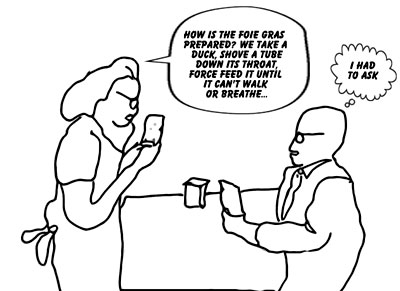
-
Extreme Growth Promoters
Many of the growth
promoters used in US meat production are banned in other
countries.
Europe boycotts US beef because
of hormones like
oestradiol-17 and
trenbolone acetate which
it says are linked to prostate and breast cancer. The EU
also disallows farmers to use antibiotics and arsenic as
growth promoters, which the US does. (Yes, arsenic.) Still,
it is some consolation that most US growth promoters are
withdrawn in the weeks before slaughter.
Not so with ractopamine, an
asthma-like drug given to 60 to 80 percent of US pigs, 30
percent of ration-fed cattle and an undisclosed number of
turkeys.
Ractopamine, which few are aware
of, is given during the last weeks of life and not withdrawn
before slaughter.
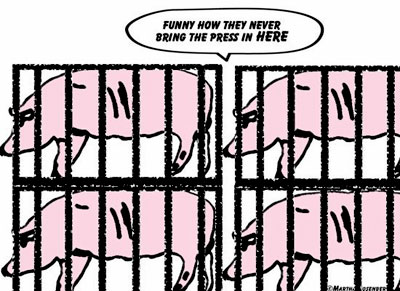
-
Mad Cow Disease - It's Baaaaaack
Does anyone remember the
government's misinformation and ineptitude with the first
three mad cows, now that the disease is baaaaacck?
With the
first cow, a government report said all
"potentially-infectious product" had been "disposed of " in
a landfill but the San Francisco Chronicle and Los Angeles
Times said it went to California restaurants where it was
eaten.
That's very different. With the second cow,
authorities did not even realize it had mad cow disease for
seven months!
The government's final report says the farmer
who sold the cow was "relatively sure" he had not kept any
offspring but "there were essentially no records
maintained."
Want more reassurances? The ranch was cleared
to resume selling meat within one month.
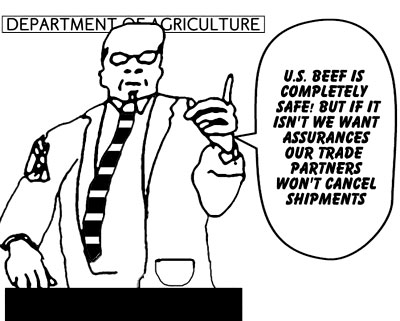
-
Brave New Clones
The FDA says clones and
their offspring are no different from other food animals and
won't be labeled. (See: rBGH.)
But in its own 2008 report it
cites cloned calves with elevated glucose, elevated growth
indicators, early mammary development, umbilical abscesses
and high white blood cell counts. Even the meat and milk is
different in one study, the FDA admits.
Are Americans eating
unlabeled clones right now?
"I can't say today that I can
answer your question in an affirmative or negative way,"
replied Agriculture Secretary Tom Vilsack to the question in
2010. (Why should the ag secretary know?)
"I don't know.
What I do know is that we know all the research, all of the
review of this is suggested that this is safe."
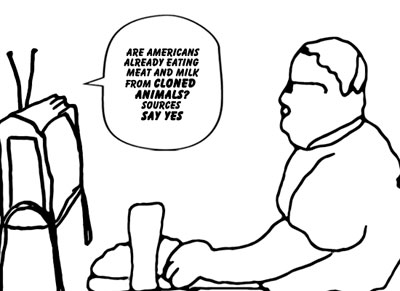
Foie Gras
Delicacy of Despair
May 2012
from
PETA Website
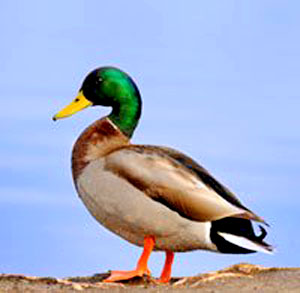
To produce "foie gras" (which literally
means "fatty liver"), workers ram pipes down male ducks' or geese's
throats two or three times daily and pump as much as 4 pounds of
grain and fat into the animals' stomachs, causing their livers to
bloat to up to 10 times their normal size.
Many birds have difficulty standing
because of their engorged livers, and they may tear out their own
feathers and cannibalize each other out of stress.
The birds are kept in tiny wire cages or packed into sheds. On some
farms, a single worker may be expected to force-feed 500 birds three
times each day. Because of this rush, animals are often treated
roughly and left injured and suffering.
A PETA investigation at Hudson Valley Foie Gras in New York (then
called "Commonwealth Enterprises") found that so many ducks died
when their organs ruptured from overfeeding that workers who killed
fewer than 50 birds per month were given a bonus. Many ducks develop
foot infections, kidney necrosis, spleen damage, bruised and broken
bills, and tumor-like lumps in their throats.
One duck had a maggot-infested neck
wound so severe that water spilled out of it when he drank.
Other investigations at Hudson Valley Foie Gras and America's other
leading foie gras producer, Sonoma Foie Gras in California, revealed
that ducks were crammed into filthy, feces-ridden sheds and that
others were isolated in wire cages that were so small that they
could barely move.
Investigators also observed barrels full
of dead ducks who had choked to death or whose organs had ruptured
during the traumatic force-feeding process.
The investigators
rescued 15 ducks, including two who were being eaten alive by rats
because they could not move.
Kate Winslet narrates this shocking
undercover footage
of the torture that ducks and geese
endure in foie gras production.
Foie gras is so inhumane that in 2004
California passed a law banning the sale and production of foie gras
effective in 2012.
Force-feeding has also been outlawed in,
-
the U.K.
-
Austria
-
Germany
-
the Czech Republic
-
Finland
-
Italy
-
Luxembourg
-
the Netherlands
-
Norway
-
Poland
-
South Africa
-
Sweden
-
Switzerland
-
Denmark
-
Israel
Join Sir Roger Moore and countless
others around the world in refusing to eat foie gras.
You can even take one more step by
giving up all animal products for one month.
|










